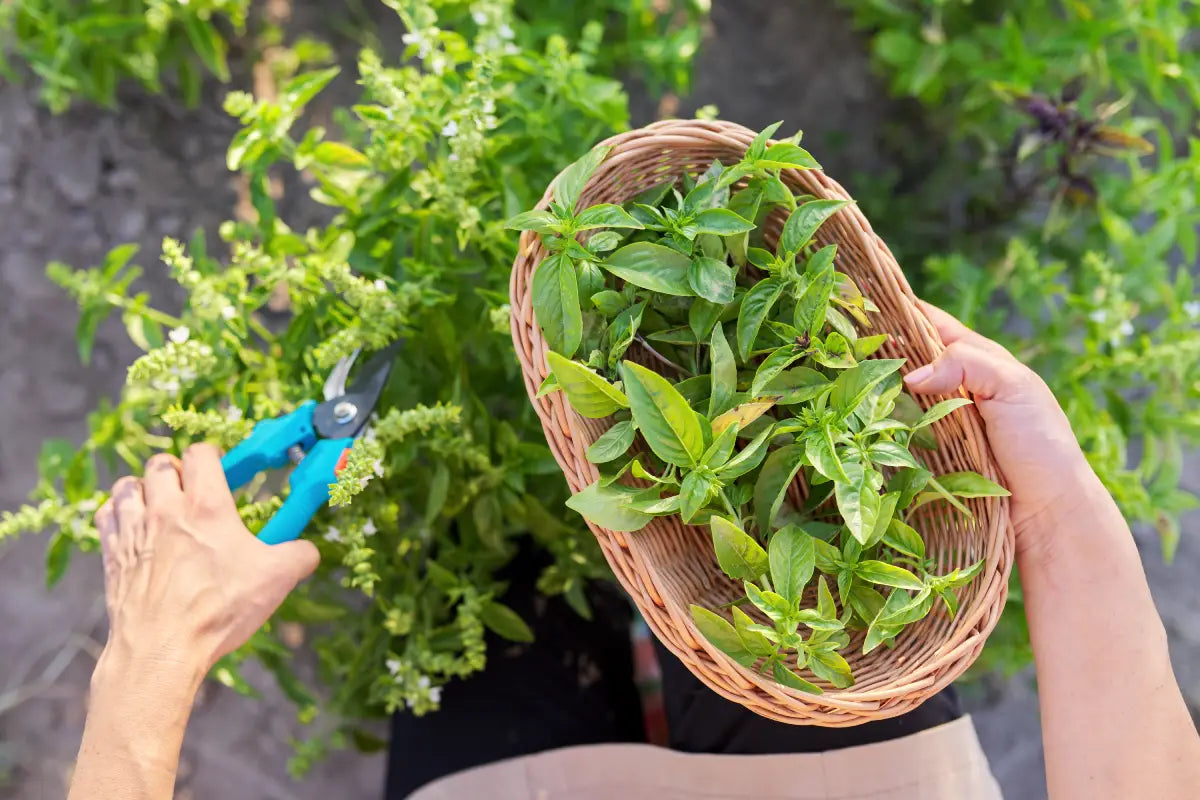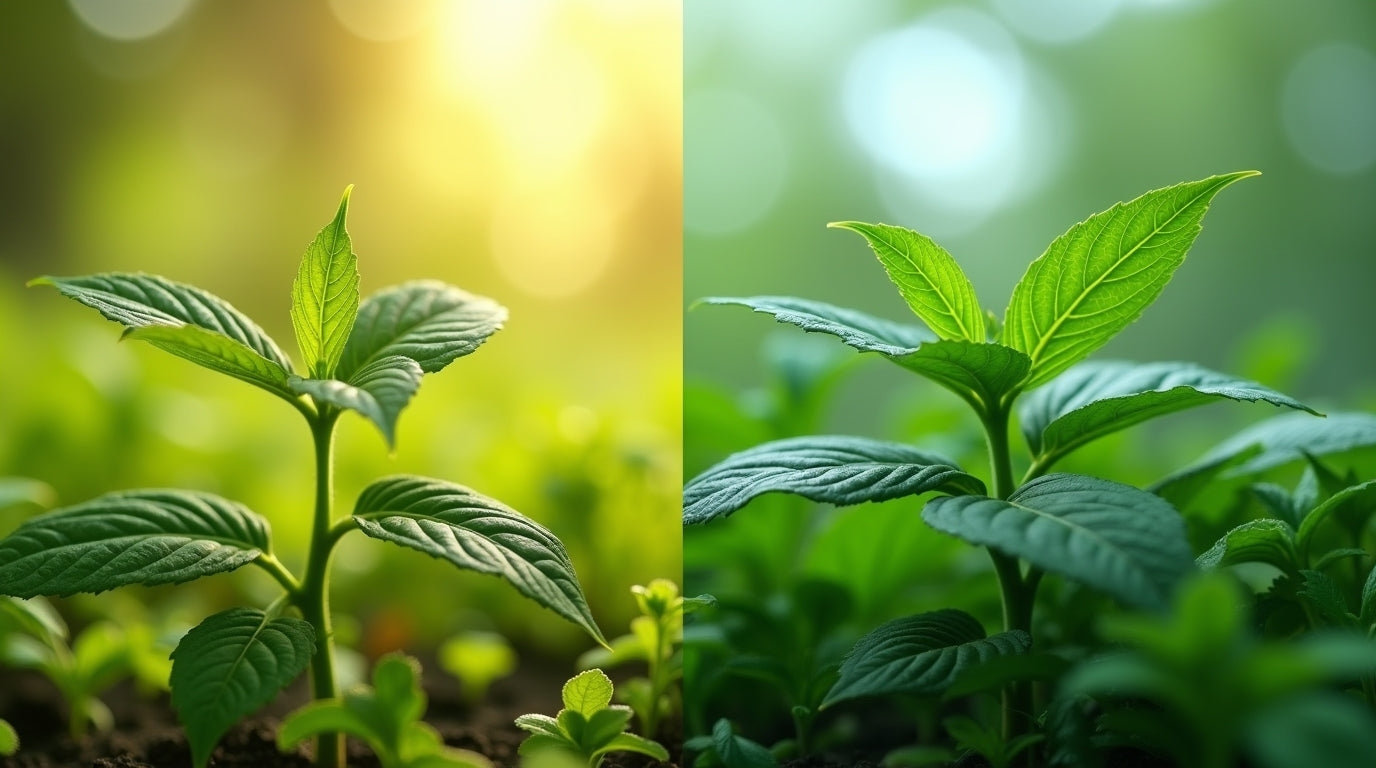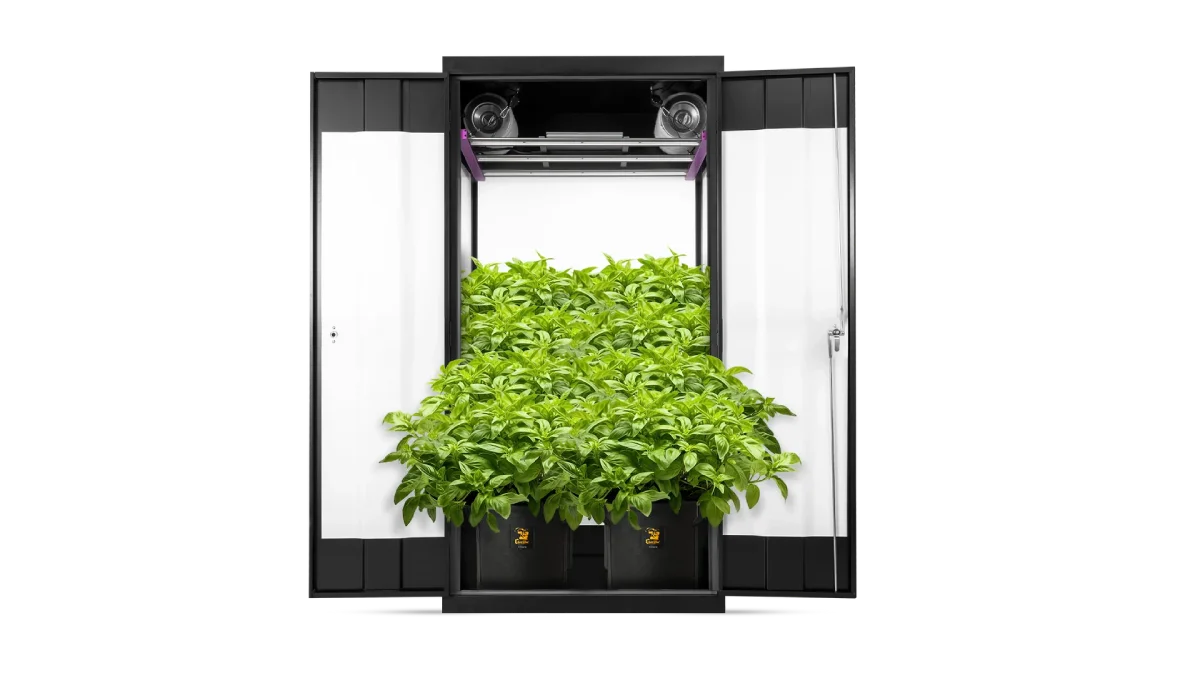
How to Harvest Basil: A Step-by-Step Guide for Continuous Growth
Quick Answer: Harvest basil by pinching or cutting stems just above a pair of leaves, starting when plants are 4-6 weeks old. Always harvest from the top, remove flower buds immediately, and never take more than 1/3 of the plant at once. This technique encourages bushier growth and continuous leaf production throughout the growing season.
Growing fresh basil is one of the most rewarding experiences for any gardener, but knowing how to harvest it properly makes the difference between a few scattered leaves and an abundant, continuous supply of aromatic herbs. Whether you're growing basil in your garden or in a controlled indoor environment, proper harvesting techniques will keep your plants healthy, productive, and flavorful for months.
This comprehensive guide will teach you the expert techniques used by professional growers to maximize basil yields while maintaining plant health throughout the entire growing season.
The Science Behind Proper Basil Harvesting
Understanding why specific harvesting techniques work is essential for achieving optimal results with your basil plants. Basil responds to harvesting through a biological process that determines future growth patterns and overall plant productivity.
How Basil Grows and Responds to Harvesting Basil plants grow from terminal and lateral buds located at leaf nodes along the stem. When you harvest correctly by cutting above a node, you trigger the plant to produce two new shoots from that point, effectively doubling the number of growing tips. This process, called apical dominance release, is the key to creating bushy, productive basil plants.
The Flowering Challenge Once basil begins flowering, it shifts energy from leaf production to seed development, causing leaves to become smaller, less flavorful, and often bitter. Proper harvesting techniques prevent this flowering response, keeping plants in their vegetative growth phase where they produce the largest, most aromatic leaves.
Timing and Plant Stress Management Harvesting at the right time and using proper techniques minimizes plant stress while maximizing recovery speed. Well-timed harvesting actually strengthens plants by removing older, less efficient leaves and encouraging robust new growth with higher essential oil concentrations.

When to Start Harvesting Your Basil Plants
Timing your first harvest correctly sets the foundation for a productive basil-growing season. Understanding the right indicators ensures you begin harvesting at the optimal moment for maximum plant health and yield.
Plant Maturity Indicators Begin harvesting basil when plants reach 4-6 weeks old and have developed 6-8 sets of true leaves. At this stage, plants are established enough to handle harvesting stress while still young enough to respond with vigorous new growth.
Look for these specific signs your basil is ready for first harvest:
- Stems are sturdy and at least pencil thickness
- Plants have reached 6-8 inches in height
- Multiple branching points are visible along main stems
- Leaves are fully developed with rich green color and strong aroma
Optimal Daily Timing Harvest basil in the early morning after dew has evaporated but before afternoon heat stress. This timing ensures maximum essential oil concentration in leaves while minimizing plant stress. Avoid harvesting during the heat of the day or when plants are water-stressed.
Indoor Growing Advantages Indoor basil grown in controlled environments like Gorilla grow tents can be harvested year-round without seasonal limitations. Controlled temperature, humidity, and lighting conditions allow for more frequent harvesting and faster plant recovery compared to outdoor growing.
Step-by-Step Basil Harvesting Technique
Mastering the proper harvesting technique is crucial for maintaining healthy, productive basil plants throughout the growing season. Follow these precise steps for optimal results every time.
Step 1: Identify Harvest Points Locate stems with at least 4-6 pairs of leaves above the base of the plant. Never harvest from the bottom two pairs of leaves, as these are essential for plant energy production and recovery.
Look for stems where you can see clear nodes (the points where leaves emerge from stems) with small developing leaves or shoots in the leaf axils.
Step 2: Make the Perfect Cut Using clean, sharp scissors or pruning shears, cut the stem ¼ inch above a pair of leaves, making the cut at a slight angle to prevent water accumulation. This precise placement ensures new shoots will emerge from the leaf axils below your cut.
Never tear or rip basil stems, as this creates wounds that are susceptible to disease and slower to heal. Clean cuts heal faster and reduce plant stress.
Step 3: Harvest Amount Guidelines Never remove more than one-third of the plant's total foliage in a single harvesting session. This guideline ensures the plant retains enough leaf surface area for continued photosynthesis and energy production.
For mature plants, you can typically harvest 2-4 main stems per session, depending on plant size and branching development.
Step 4: Post-Harvest Plant Care After harvesting, water plants thoroughly but avoid getting water on cut stems or remaining leaves. Good air circulation prevents moisture-related diseases while plants recover from harvesting stress.
Monitor plants for the next 2-3 days to ensure proper healing and watch for new growth emerging from harvest points.

Advanced Harvesting Strategies for Maximum Production
Professional growers use specific techniques to maximize basil production while maintaining plant health throughout extended growing seasons. These advanced strategies can significantly increase your total harvest.
The Pinching vs. Cutting Debate Both pinching and cutting can be effective, but cutting with clean tools provides more precise control and reduces disease risk. Pinching works well for soft, young growth but can damage tougher stems on mature plants.
For optimal results, use sharp scissors for main harvests and gentle pinching only for removing flower buds and very tender tip growth.
Creating a Harvesting Schedule Regular harvesting every 7-10 days during peak growing season keeps plants in optimal production mode. This frequent harvesting prevents flowering while encouraging continuous branching and leaf development.
During cooler periods or slower growth, extend the harvesting interval to 14 days to allow adequate recovery time between sessions.
Flower Bud Management Remove flower buds immediately upon appearance, before they begin opening. These buds typically appear at the top of main stems and in leaf axils of mature plants.
Pinch flower buds daily during peak season, as new buds can appear rapidly under ideal growing conditions. This vigilant management keeps plants producing flavorful leaves instead of setting seed.
Selective Harvesting for Plant Shape Harvest primarily from the center and top of plants to encourage outward branching and bushier growth. This technique creates fuller plants with more harvesting points.
Remove any stems growing inward toward the plant center, as these create poor air circulation and increase disease risk.
Optimal Growing Conditions for Productive Basil
Creating the ideal environment for basil growth directly impacts harvesting success and plant productivity. Proper environmental control ensures maximum leaf production and faster recovery between harvests.
Temperature and Light Requirements Basil thrives in temperatures between 70-85°F during the day and 60-70°F at night. Indoor growing with LED lights provides consistent lighting for 12-16 hours daily, ensuring rapid growth and frequent harvesting opportunities.
Full-spectrum LED grow lights positioned 12-18 inches above plants provide optimal light intensity for vigorous basil growth without generating excessive heat that could stress plants.
Humidity and Air Circulation Maintain 40-60% relative humidity for optimal basil health. Professional grow tent setups with proper ventilation systems provide ideal air circulation while maintaining optimal humidity levels.
Good air movement prevents fungal diseases while strengthening plant stems, making them more resilient to regular harvesting stress.
Container and Soil Considerations Gorilla grow bags provide excellent drainage and root aeration for container-grown basil. The fabric construction prevents root binding while promoting healthy root development that supports vigorous leaf production.
Use well-draining potting mix enriched with compost for optimal nutrient availability and root health.
Environmental Monitoring GXi temperature and humidity sensors provide real-time monitoring of growing conditions, alerting you to any environmental changes that could affect plant health or harvesting schedules.
Consistent environmental conditions result in more predictable growth patterns and easier harvest planning.
Preserving and Storing Your Basil Harvest
Proper post-harvest handling and storage techniques ensure you get maximum value from your carefully cultivated basil. Different preservation methods work better for different uses and storage timeframes.
Immediate Use and Short-Term Storage For immediate use within 2-3 days, store fresh basil stems in water at room temperature, similar to cut flowers. Cover leaves loosely with a plastic bag to maintain humidity while allowing air circulation.
Never refrigerate fresh basil if you plan to use it within a few days, as cold temperatures damage the delicate leaves and reduce flavor quality.
Drying Methods for Long-Term Storage Air drying works well for basil harvested in dry conditions. Bundle small groups of stems and hang in a warm, dry, well-ventilated area away from direct sunlight. Properly dried basil retains flavor for 6-12 months.
Oven drying provides faster results: spread leaves on baking sheets and dry at lowest oven temperature (170°F or lower) for 2-4 hours until crispy.
Freezing Techniques Blanch and freeze method: briefly blanch leaves in boiling water for 2 seconds, immediately plunge into ice water, pat dry, and freeze in portions. This method preserves color and flavor better than raw freezing.
Oil-based freezing: blend fresh basil with olive oil and freeze in ice cube trays for convenient cooking portions.
Making Pesto and Herb Butters Transform large harvests into pesto, herb butters, or flavored oils that can be frozen or refrigerated for extended storage. These value-added products make excellent use of abundant basil harvests.

Troubleshooting Common Basil Harvesting Problems
Even experienced growers encounter challenges with basil harvesting and plant management. Understanding common issues and their solutions helps maintain productive plants throughout the growing season.
Plant Not Responding to Harvesting Symptoms: Slow regrowth after harvesting, weak new shoots, or declining plant vigor Causes: Over-harvesting, poor growing conditions, or inadequate nutrition Solutions: Reduce harvesting frequency, improve environmental conditions, and provide balanced fertilizer to support recovery
Premature Flowering Despite Regular Harvesting Symptoms: Flower buds continue appearing even with frequent removal Causes: Plant stress, inadequate nutrition, or environmental fluctuations Solutions: Improve growing conditions, ensure consistent watering, and check for adequate light levels
Bitter or Poor-Flavored Leaves Symptoms: Leaves taste bitter or lack typical basil aroma Causes: Flowering has begun, plants are stressed, or harvesting timing is poor Solutions: Remove all flowers immediately, harvest in early morning, and ensure plants receive adequate water and nutrients
Slow Recovery Between Harvests Symptoms: New growth takes longer than 7-10 days to develop Causes: Poor environmental conditions, inadequate light, or plant stress Solutions: Optimize temperature and humidity, increase light intensity, and allow longer recovery periods between harvests
Maximizing Basil Production Throughout the Season
Professional techniques for extending the productive life of basil plants ensure maximum harvest yields throughout the entire growing season.
Succession Planting Strategy Start new basil plants every 2-3 weeks to ensure continuous harvests even as older plants decline. This staggered approach provides fresh, vigorous plants replacing those reaching the end of their productive life.
Plant Renovation Techniques When plants become too large or begin declining, cut them back to 4-6 inches above soil level. This drastic pruning often rejuvenates older plants, providing several more weeks of productive growth.
Seed Collection for Next Season Allow a few plants to flower and set seed at the end of the growing season. Collect seeds when flower heads turn brown and dry for next year's planting.
Winter Growing Considerations Indoor growing systems with supplemental lighting allow year-round basil production. Reduce harvesting frequency during winter months when growth naturally slows.
FAQ Section
How often can I harvest basil from the same plant? You can harvest basil every 7-10 days during peak growing season, provided you never remove more than 1/3 of the plant at once. This frequent harvesting actually encourages more growth and prevents flowering.
Should I cut or pinch basil when harvesting? Use clean, sharp scissors or pruning shears for best results. Cutting provides more precise control and reduces disease risk compared to pinching, especially on mature stems.
What happens if I let my basil flower? Once basil flowers, leaves become smaller and bitter as the plant focuses energy on seed production. Remove flower buds immediately to maintain leaf quality and continued production.
Can I harvest basil in the rain or when wet? Avoid harvesting wet basil, as moisture increases disease risk and reduces storage life. Wait until leaves are completely dry, preferably harvesting in early morning after dew evaporates.
How do I know if I'm over-harvesting my basil? Signs of over-harvesting include slow regrowth, weak new shoots, yellowing leaves, or plant decline. If this occurs, reduce harvesting frequency and improve growing conditions.
Why do my basil leaves turn black after harvesting? Black edges on harvested basil indicate cold damage or poor storage conditions. Store fresh basil at room temperature and avoid refrigeration for short-term storage.
Can I harvest basil grown indoors differently than outdoor plants? Indoor basil can be harvested more frequently due to controlled growing conditions. However, the same basic techniques apply: harvest above leaf nodes and never take more than 1/3 of the plant.
Summary
Key Takeaways: Successful basil harvesting requires proper timing, technique, and environmental control. Start harvesting at 4-6 weeks, always cut above leaf nodes, remove flower buds immediately, and maintain optimal growing conditions for continuous production throughout the season.
Maximize your basil harvest success with professional growing equipment designed for optimal herb production. From precise environmental monitoring to quality growing containers, every component works together for exceptional basil yields.
Ready to start growing your own abundant basil supply? Explore our complete indoor growing systems and LED lighting solutions perfect for year-round herb production.
Learn more about successful herb cultivation with our guides on indoor basil growing, grow tent setup for beginners, and optimal temperature monitoring.

Lena Myles
I'm a mushroom enthusiast and home cook based in Oregon. I'm passionate about foraging and creating fungi-focused recipes, especially delicious, plant-based dishes using gourmet mushrooms like trumpet, shiitake, and oyster. When I’m not in the kitchen, you’ll usually find me wandering the woods in search of new wild flavors.


